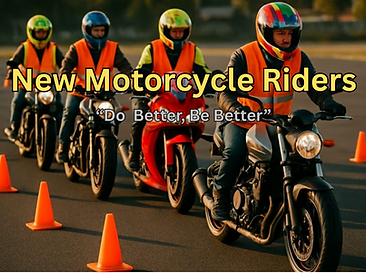Understanding the Challenges: Why Learning to Ride a Motorcycle Can Be Difficult
- NMR

- May 7
- 3 min read
Learning to ride a motorcycle can be a thrilling journey. However, it also comes with several hurdles that can make the process tough. Whether you are a complete beginner or looking to polish your skills, multiple factors can impact your learning experience. This post will explore these challenges and provide actionable insights to help you navigate them more effectively.
Learning Curve
The learning curve when starting to ride a motorcycle can feel steep. Unlike driving a car, where you primarily focus on steering and gas, riding a motorcycle demands coordinated movements and a better understanding of balance.
For instance, in 2021, research showed that about 40% of beginner riders struggled with low-speed maneuvers. Mastering the lean required for turns and building muscle memory for throttle and clutch control are critical, yet challenging for newcomers. Practicing in a safe, controlled environment can help solidify these skills.
Fear and Anxiety
Fear is often one of the biggest challenges for new riders. Concerns about safety, such as the risk of falling, can create a mental block.
A survey conducted with beginners revealed that nearly 60% reported feeling anxious during their first few rides. This anxiety can distract you from focusing on crucial riding techniques. To combat this, techniques like deep breathing or visualization can help build confidence and manage fear. Gradually facing your fears by starting in safe settings can also ease anxiety.
Physical Demands
Riding a motorcycle is a physical activity that requires strength and endurance. Unlike cars, where most tasks involve simple steering, motorcycling demands considerable body control and stamina.
For example, during practice sessions, many beginners find it challenging to hold the bike steady while navigating turns or operating both the clutch and brakes simultaneously. A study showed that riders who engaged in fitness training saw a 25% improvement in their handling abilities. Engaging in strength and flexibility exercises can greatly enhance your confidence on the bike.
Traffic and Environmental Awareness
Navigating traffic can be daunting for new motorcyclists. Riders must maintain constant awareness of their surroundings while focusing on their motorcycle’s operation.
For example, a report indicates that 80% of motorcycle accidents occur due to a lack of awareness of surrounding traffic. New riders should take time to learn road rules and environmental cues. Start by practicing in low-traffic areas before tackling busy streets. Understanding how weather impacts road conditions can also improve your riding experience.
Equipment Familiarization
Becoming familiar with your motorcycle and safety gear adds another layer of complexity. Each bike has different controls and handles uniquely.
It's essential to learn how to operate various components like the throttle, clutch, and brakes effectively. According to a survey, over 70% of motorcycle beginners felt a lack of confidence because they didn’t understand their gear. Spending time learning about your bike and selecting quality safety gear like helmets and gloves is crucial for your safety and comfort.
Inexperience
Inexperience can slow down your progress significantly. Riding well requires time and practice to develop the required skills and instincts.
Many beginners have limited time on the bike, which can lead to slow skill development. A study found that riders who logged at least 100 hours of practice showed marked improvement in their riding proficiency. It’s important to be patient with yourself and recognize that mastery takes time.
Misconceptions About Riding
Many newcomers enter the world of motorcycling with misconceptions that can lead to frustration. Some believe that learning to ride can be as simple as jumping on the bike and hitting the road.
Unfortunately, this belief can lead to disappointment when faced with the reality of learning to ride. Education is crucial. Professional motorcycle training and extensive reading can help demystify the process and set realistic expectations.
Tips for Overcoming Challenges
Take a Professional Course: Structured training can provide the essential knowledge and skills needed to ride safely.
Start with a Smaller Motorcycle: A lightweight bike is often easier to control, helping you gain confidence.
Practice Mindfulness: Techniques like deep breathing can help manage fear and improve your focus.
Gradually Expose Yourself to Traffic: Start in quieter areas and slowly move to busier locations as you gain confidence.
Review Controls Regularly: Get comfortable with your motorcycle's features to boost your confidence.
Be Patient: Remember, learning to ride takes time. Allow yourself the space to grow and improve.
Embrace the Learning Journey
Learning to ride a motorcycle is a fulfilling endeavor filled with both challenges and victories. By recognizing the difficulties you may face, you can prepare yourself to tackle them head-on. Whether it's overcoming fear, enhancing your physical fitness, or committing time to practice, patience and dedication are key.
Remember, every seasoned rider once faced the same challenges. Embrace the journey, stay patient, and enjoy the ride!






.png)



Comments